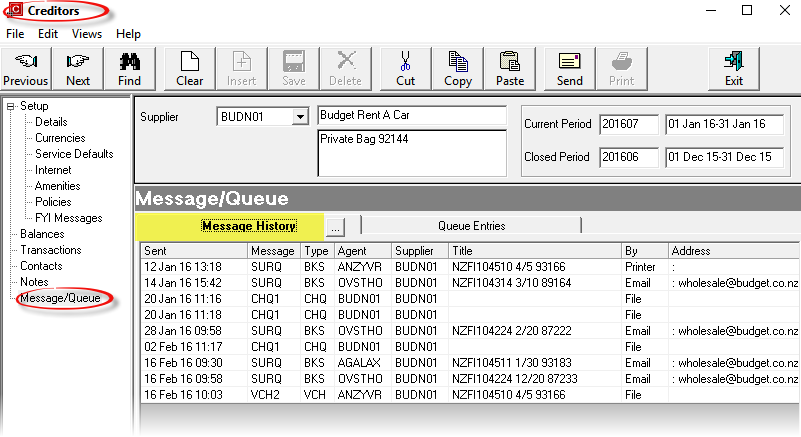
The Message/Queues node provides details of messages sent to the supplier and internal queue messages regarding the supplier. Messages which are sent from bookings to the supplier as well as messages sent from this supplier screen display here.
In addition a general message can be sent to the supplier from any node except Transactions in the Creditors application.
There are some rules which apply that determine which, if any, messages and queue entries display:
Full detail on setting up queues and messages are in the System Setup Training Guide.
Screen Shot 159: Creditors Message History Screen


|
The column headings at the top of these scrolls are the default headings for this screen. A full list of column headings available in this scroll is under Scroll Column Headings, Message History. |
Messages which display in this screen can be filtered by clicking the Search button ( ) on the Message History tab.
) on the Message History tab.
Screen Shot 160: Filter Messages Dialogue
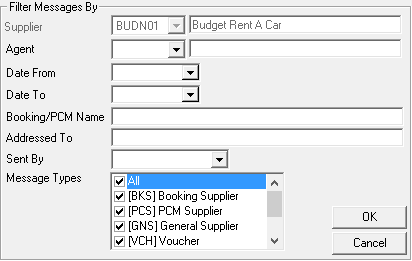
Supplier (Drop-down)
Defaults to the current supplier and cannot be changed.
Agent (Drop-down, Display Only)
Allows supplier messages to be filtered based on a booking agent.
Date From (Date)
Display only messages after the date specified.
Date To (Date)
Display only messages before a specified date.
Booking/PCM Name (60 Characters)
Only supplier messages relating to the specified booking or PCM name.
Addressed To (60 Characters)
Only supplier messages addressed to a specific fax or email number/address.
Sent By (Drop-down)
Only supplier messages sent by a specific Tourplan user name.
Message Types (Multi Select List Box)
Select messages of a specific type.
To view a message, double click the line.

|
The message contents can only be viewed if Full or Text History is being kept. |
Screen Shot 161: View Sent Message


|
The message can only be edited, altered or re-sent provided the history type allows 'Resend, Messages which do not allow resend (see Message History above) will display only a Cancel button. |
Queues provide a means of sending messages amongst Tourplan users or groups of users on a common Tourplan system. These permit workflow based reminders to be queued for some future action. They are context sensitive and can be attached to a booking, PCM, agent and/or supplier and therefore be viewed from a number of areas within the system.
Queue messages can be viewed or sent from this screen.
Full details on setting up and using queues are in the System Setup Training Guide.
Screen Shot 162: Queue Entries Screen
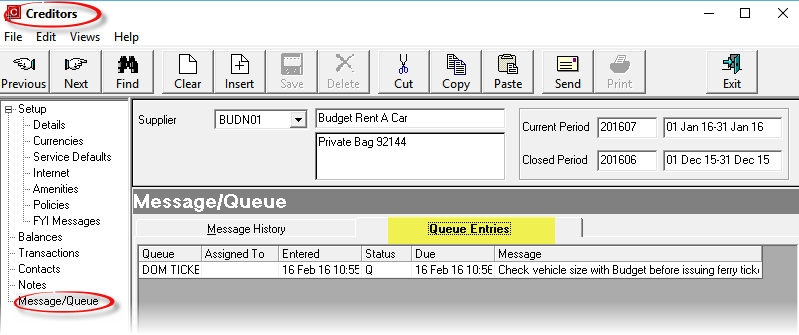

|
The column headings at the top of this scroll are the default headings for this screen. A full list of column headings available in this scroll is under Scroll Column Headings, Queue Entries |
A general (non-booking specific) message can be sent from the Creditors application to a creditor/supplier. A general supplier message format simply holds addressing information and allows a message to be typed and sent to the supplier.
To send a message, select the creditor/supplier the message is to be sent to and then click the Send button  in the button bar. The message selection dialogue will display.
in the button bar. The message selection dialogue will display.
Screen Shot 163: Message Selection Dialogue
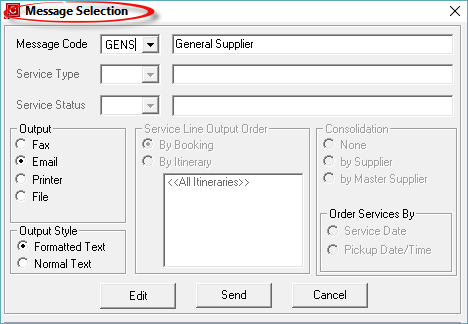
Message Code (Drop-down)
A list of available, valid message types will display in the drop-down.

|
Only message formats that have been set up as a General Supplier message type will be available for selection. These formats must first be set up in the System Messaging application. |
Output (radio button)
The output method set by the System INI setting MS_DEFAULT_SEND_MODE will determine which of the radio buttons is checked. The output mode can be changed here, or in the message editing screen. The valid output options are:
Output Style (radio button)
The default is Formatted Text. This means that the message will be output in RTF (Rich Text Format) which includes graphics (if embedded in the document). Normal Text is designed to be used with Dot Matrix style printers which do not offer graphics support.
All other output options are disabled, since they can only be used with messages being output from within a booking.
Edit/Send/Cancel (Buttons)
When the Edit button is clicked, the message editor window opens.
Screen Shot 164: General Supplier Message Editing Screen
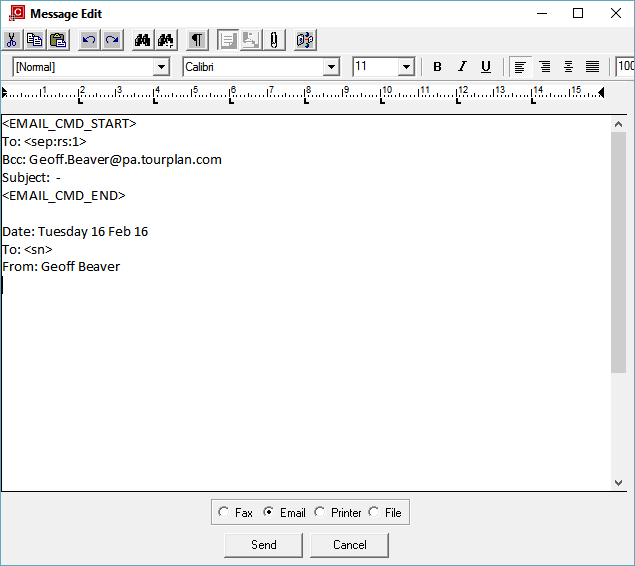
Because general supplier message formats are designed to allow free format editing, the Message Edit screen is generally blank except for the fax and/or email addressing detail.

|
The addressing detail should not be edited or removed. Any changes to them could make message sending invalid. If the message is to be sent to Printer or File, these commands will be stripped out prior to output, provided the INI setting MSG_IGNORE_FAX_EMAIL_NOS has been set. |
When the message has been entered, the output can be changed if necessary. Depending on the output method, differing dialogues will display when the Send button  is clicked. Phone/fax numbers are substituted at this time and dependent on phone book set up and content, confirmation or selection of a phone or fax number may be required if there are multiple contacts set up for the supplier.
is clicked. Phone/fax numbers are substituted at this time and dependent on phone book set up and content, confirmation or selection of a phone or fax number may be required if there are multiple contacts set up for the supplier.

|
If there are multiple contacts and there are no contact types specified with the phone/fax/email substitution codes in the message address or body sections, then confirmation or selection of a number may be required a number of times. If the message header or body makes reference to a phone number (<phone>); fax number (<sfp>) and email address (<sep>), and no contact type is set up or valid, then confirmation will be sought on 3 separate occasions. |
Fax (radio button)
Tourplan will deliver the message to the folder nominated in the System INI setting MS_FAX_OUTPUT. This should be a folder being polled by Tourplan compliant fax software (if installed).
Email (radio button)
Tourplan will call the Windows MAPI spooler and deliver the message to the MAPI compliant email client. Note in Screen Shot 164 General Supplier Message Editing Screen, an additional button becomes live when email is selected as the output method.
Click the paperclip icon (highlighted yellow below) to open a window showing files already attached to the message.
Screen Shot 165: Email Message Output–Attach Document Button
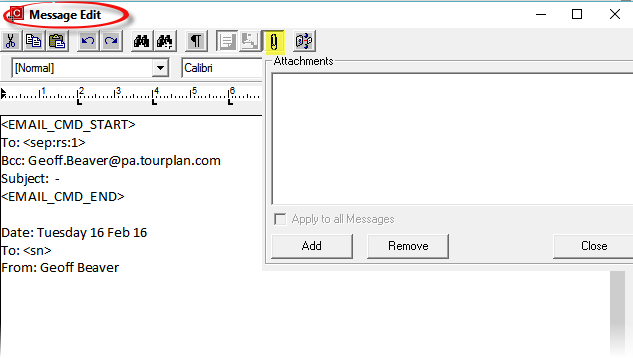
From this window, the Add button  opens the standard Windows Find Attachment dialogue.
opens the standard Windows Find Attachment dialogue.
To remove an already attached file, highlight the file to be removed and click the Remove button  .
.
When finished with attachments, click the Close button  .
.
Printer (radio button)
The standard Windows Printer Selection dialogue displays enabling a printer to be selected. Any system required addressing detail (see Screen Shot 164 General Supplier Message Editing Screen) is stripped out before printing provided the System INI setting MSG_IGNORE_FAX_EMAIL_NOS is set to Y.
File (radio button)
The message can be output to a disk file in Plain Text (.txt), Rich Text (Word processor format–RTF) or Portable Document Format (PDF).